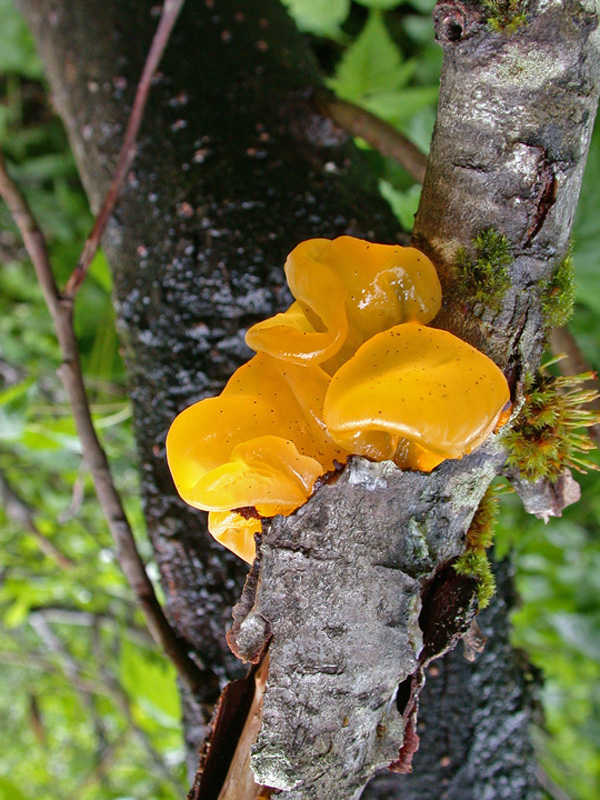On a stroll through the forest, occasionally a small, bright orange or yellow spot attracts the eye. Looking more closely, one can see that they are fungi of jelly-like consistency, growing on dead twigs and branches. The majority of each individual fungus is comprised of long filaments (technically hyphae) that burrow through the decaying wood. The bright color is displayed by fresh spore-producing bodies that release spores when mature, but age turns the orange or yellow to dull brownish. Some species of jelly fungi occur chiefly on dead conifer branches, while others live on dead branches of deciduous woody plants. Another kind is a parasite on other fungi that contribute to the decay of woody plants, frequently growing on the hyphae of the host fungus, inside the dead wood, so it may look like the parasite is growing directly on the wood. Some of these very colorful fungi look rather like tiny golf tees. Others are lumpy blobs or convoluted ribbons, and a blobby species sometimes can look a lot like a convoluted species; two of these, in different genera, bear a common name of witch’s butter.
I thought perhaps I could learn to identify these jelly fungi in the field, at least to genus, without doing the strict mycological method of looking at the spores under a microscope. Ach, not so easy! We have several species of orange jelly fungi. Some seem to be distinguishable to genus (but not to species) even in the field, but others, particularly the witch’s butters, are more difficult. More experience needed!
In addition to the orange witch’s butters, there’s a black jelly fungus called black witch’s butter, a species of Exidia, which grows on the wood of deciduous trees. For me, this begs the question of why these fungi display these colors. Do the pigments serve some particular functions?
Thinking about the common name of these fungi made me wonder about the prevalence of witches in the common names of local organisms. In addition to the ‘butter,’ we have witches’ brooms caused by parasitic mistletoe, mostly in hemlocks. And there is witches’ hair, a stringy, tangled lichen that often festoons tree branches and is eaten by deer and mountain goats. And then there are all the things associated with devils, too — devil’s club in the forest understory, and the Devil’s Paw (which fronts the ‘Hades Highway’) and Devil’s Thumb poking up out of the icefield. Hmmm, the practitioners of the black arts seem to be everywhere!
In the same vein — there is a moss called goblin’s gold, which lives in moist, dark little grottos in rocks or under rootwads of fallen trees. It is not very common here, but we found it once. It is luminescent, because special lens-shaped cells in part of the plant capture even dim light, and the adjacent chloroplasts (which contain the green photosynthetic pigment) then gleam a greenish-gold. So a little stand of this moss can, at least to some imaginations, suggest a goblin’s hoard in a small cave. It is not the leafy part of the moss that reflects the light; it is the ‘juvenile’ thread-like part (technically the protonema), which is retained when the moss matures and makes its leaves.
Early February was brightened up a bit by seeing a flock of redpolls foraging on alder cones. I usually begin to see them sometime in February or early March, as they move around from one alder stand to another. They nest in the Interior but irrupt in huge numbers about every other year, moving southward over much of North America in response to shortages of seeds in their northern nesting areas. Smaller numbers probably come to us in Southeast almost every year. They can eat lots of small seeds, such as those of alder, at a time, storing them in an expanded part of the esophagus. Later, they can regurgitate the seeds, remove the husks, and swallow the kernel. Very convenient for keeping a full tummy during the long winter nights.
Thanks to Dr. Gary Laursen, mycologist, for patient, helpful consultation.
Mary F. Willson is a retired professor of ecology.

